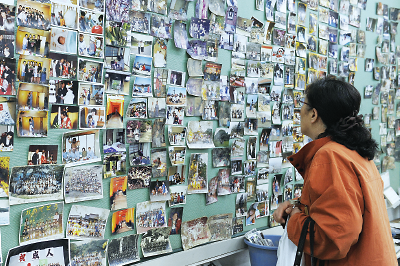Social Networks Affect Post-Disaster Mental Health Outcomes
Abstract
The loss of community following a disaster appears to increase the risk of dementia, PTSD, and depression in survivors.
When a natural disaster hits, it doesn’t just affect a disparate group of people, it affects an interconnected community. Yet the role that social structure and personal connections have on mental health after a disaster is not well-studied.

A woman looks at photos recovered from rubble in northern Japan after an earthquake and tsunami caused great devastation there in 2011. Two recent studies assessing the mental health of people who experienced a natural disaster point to the important role that one’s community plays in recovery following loss.
Two recent studies assessing the mental health of people who experienced a natural disaster highlight the important role one’s community plays in recovery following loss. Such insight could help guide social interventions for disaster survivors.
The first study tracked a cohort of people participating in an aging study in Iwanuma, Japan—just west of the center of the 2011 earthquake and tsunami that devastated the region—to examine potential disaster-related outcomes that might increase dementia risk.
Ichiro Kawachi, M.B.Ch.B., Ph.D., the John L. Loeb and Frances Lehman Loeb Professor of Social Epidemiology at Harvard’s T.H. Chan School of Public Health, and colleagues contacted over 3,500 survivors in the Iwanuma study cohort to assess their cognitive status and personal experiences during the disaster in 2013. All participants were asked about the extent of property damage they experienced, whether they had friends and/or relatives who died during the disaster, and whether they stopped or started drinking or smoking. This information was then compared with existing data obtained seven months prior to the 2011 disaster.
The authors found that major housing damage was a strong predictor of dementia in older adults. In fact, the dementia risk associated with having property destroyed was similar to the risk of developing dementia after having a stroke. The findings were published online on October 24 in the Proceedings of the National Academy of Sciences.
Hiroyuki Hikichi, Ph.D., a research fellow in Kawachi’s group and lead author of the study, told Psychiatric News that subsequent analysis of people who experienced housing damage suggested that at least part of this effect was due to the loss of social interaction with neighbors (as opposed to the actual loss of property).
But while the loss of neighbors was linked with cognitive decline, Hikichi noted that the death of friends and/or relatives in the earthquake was not an independent risk factor for dementia. This suggests that maintaining some community connection can be protective.
Moving forward, Hikichi wants to test whether improving survivors’ social ties with displaced friends or relatives in the aftermath of a disaster can moderate dementia risk, which would suggest a potential preventative strategy.
In a separate study, Richard Bryant, Ph.D., a professor of psychology at the University of New South Wales, Sydney, and colleagues explored the role of social ties on the risk of developing depression or posttraumatic stress disorder (PTSD) after a disaster in Australia. This study was published November 14 in AJP in Advance.
Their cohort was a group of 558 people who had been affected by a series of brushfires in the Australian state of Victoria in February 2009 that resulted in 173 fatalities and extensive property damage. As found in other assessments of disaster survivors, there was a high prevalence of PTSD (15.6 percent) and depression (38.5 percent) in this group.
Bryant and colleagues created social network maps for this group that not only delineated friendships, but also the directionality of the ties. Connections were identified in one of three ways: closeness felt from a participant to another person, closeness to a participant nominated by another person, and reciprocal closeness.
As might be expected, the rate of depression was higher among participants who reported fewer social connections to others, but there were also patterns with more connections associated with depression. Similar to the findings by Kawachi’s group, Bryant and colleagues found that people were more likely to be depressed if they had been close with others who had left the community after the disaster. They also found that survivors tended to be more depressed if they had multiple connections with other depressed individuals—a finding the authors said could suggest depression exerts an influence effect (much like a contagious disease) or that depressed people may be drawn to each other.
A lack of connection was also associated with PTSD risk, but in this instance, survivors were more likely to report PTSD if fewer people identified a social connection with the survivor. The authors believe this reflects the gradual social withdrawal seen among people with PTSD that leads to the avoidance component of this disorder.
“Delineating social structures after disaster and how these moderate mental health trajectories can shed light on social interventions that may facilitate adjustment after disaster,” Bryant and colleagues wrote.
Kawachi’s study was supported by grants from the National Institute on Aging, the Japan Society for the Promotion of Science, and others. Bryant’s study was supported by an Australian Research Council Linkage Grant, with additional support from the Australian Red Cross, Australian Rotary Health, and others. ■



